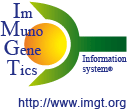Sialic acids
Definition
A family of acidic sugars found in all vertebrates. Frequently located at the outer end of glycoconjugates on cell surfaces or on secreted glycoconjugates.
- Exogenous recognition occurs when hemagglutinins / lectins / adhesins expressed by a microorganism recognize sialic acids on the cell surface of another organism, thereby permitting invasion of the latter.
- Endogenous recognition occurs within one and the same organism. When endogenous lectins (members of the selectin and siglec families in vertebrates) recognize sialic acids on the surfaces of cell.
Main sialic acids
One of the major types of sialic acids is N-acetylneuraminic acid (Neu5Ac, NANA) which is the biosynthetic precursor for most of the other sialic acids. The addition of a single oxygen atom gives rise to a very common variation, N-glycolylneuraminic acid (Neu5Gc, NGNA).
| N-acetylneuraminic acid (Neu5Ac, NANA) |
+0 ------> |
N-glycolylneuraminic acid (Neu5Gc, NGNA) |
This irreversible conversion is catalyzed by a specific hydroxylase, the CMP-sialic acid hydroxylase (or CMP-Neu5Ac (NANA) hydroxylase) that converts CMP-Neu5Ac (CMP-NANA) to CMP-Neu5Gc (CMP-NGNA). These sugar nucleotides (CMP-) are the high energy donors necessary for the addition of sialic acid to glycoconjugates in the Golgi apparatus.
| CMP-Neu5Ac (CMP-NANA) |
CMP-(Neu5Ac, NANA) hydroxylase ------> |
CMP-Neu5Gc (CMP-NGNA) |
No NGNA in Homo sapiens
Humans Homo sapiens do not express Neu5Gc (NGNA) [1]. This difference is caused by an exon deletion / frameshift mutation in the human gene coding the CMP-sialic acid (Neu5Ac, NANA) hydroxylase, resulting in a highly translated protein that appears to have no hydroxylase activity [2-3].
| [1] | Brinkman-Van der Linden EC et al., J. Biol. Chem., 275, 8633-8640 (2000). PMID: 10722703 |
| [2] | Irie A. et al., J. Biol. Chem., 273, 15866-15871 (1998). PMID: 9624188 |
| [3] | Chou HH. et al., PNAS 96, 11751-11756 (1998). PMID: 9751737 |
More information (IMGT Lexique):
Glycosylation



